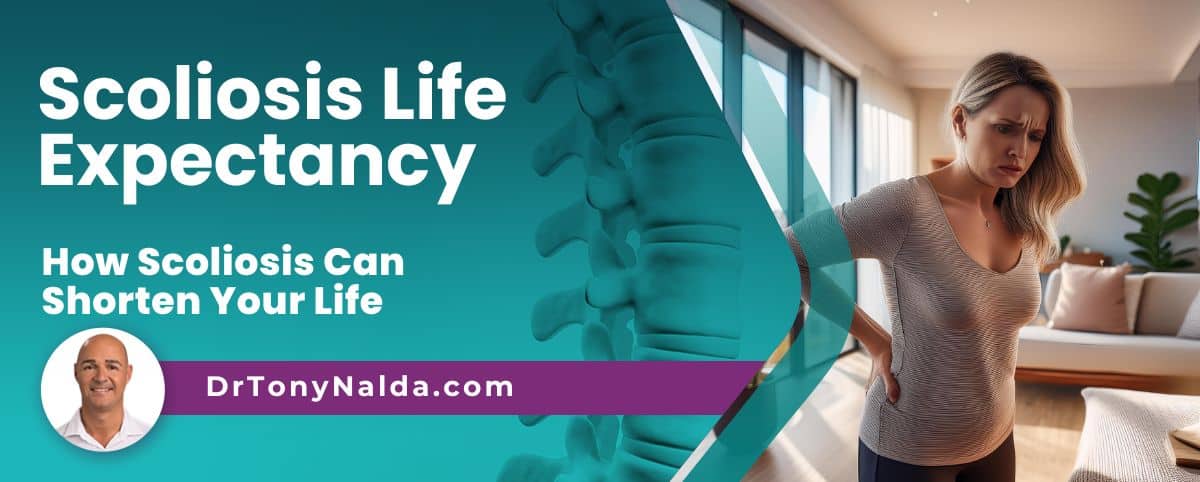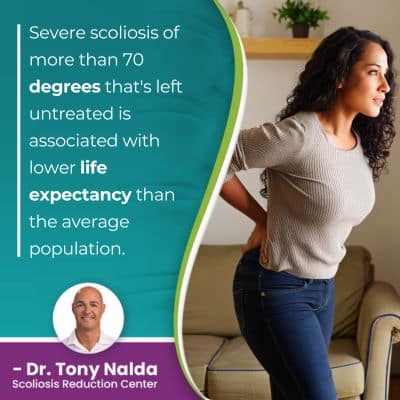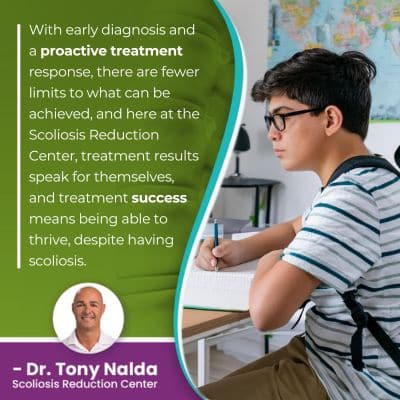Scoliosis Life Expectancy: How Scoliosis Can Shorten Your Life

Scoliosis is a progressive spinal condition, but it doesn't just affect the spine. Scoliosis can affect a patient's quality of life in a number of ways, and if not addressed and left to progress unimpeded, scoliosis life expectancy can be reduced due to complications.
Scoliosis isn't life-threatening, but if left untreated and/or is particularly severe, it can lead to complications that can impact life expectancy and quality of life. When treated proactively, scoliosis can be highly treatable, condition effects vary based on the type of scoliosis in question.
Let's start our discussion of scoliosis life expectancy with how the condition is first diagnosed.
Table of Contents
Diagnosing Scoliosis
Diagnosing scoliosis means an unnatural sideways bending and twisting spinal curve has developed, and as a 3-dimensional condition, scoliosis has to be impacted on all levels.
Scoliosis causes a loss of the spine's healthy curves, disrupting its biomechanics and function, and if left untreated, this can shape the spine's long-term spinal health and function.
Scoliosis is also a progressive condition, meaning its nature is to get worse over time, and its effects will increase as the condition gets more severe, and condition severity is determined by a measurement known as Cobb angle.
A patient's Cobb angle is determined during X-ray by drawing lines from the tops and bottoms of the curve's most-tilted vertebral bodies, and the resulting angle is expressed in degrees, and this is how conditions are classified based on severity.
The higher a patient's Cobb angle, the more severe the condition, and the more severe the spinal deformity, the more noticeable its effects are likely to be, the more progression is likely to occur, and the more capable of causing complications scoliosis is:
- Mild scoliosis is diagnosed with Cobb angle measurements of between 10 and 25 degrees
- Moderate scoliosis involves Cobb angle measurements of between 25 and 40 degrees
- Severe scoliosis is diagnosed at 40+ degrees, and very-severe scoliosis has a Cobb angle measurement of 80+ degrees
Diagnosing scoliosis means treatment is needed to minimize the condition's effects, one of which can be a lower life expectancy, and when it comes to the effects of scoliosis, in addition to wide-ranging severity levels, there are also different types of scoliosis with varying characteristics.
Different Types of Scoliosis
The main type of scoliosis to affect all ages is idiopathic scoliosis, and this means not clearly associated with a single-known cause; idiopathic scoliosis is thought to be multifactorial.
Idiopathic scoliosis accounts for approximately 80 percent of known diagnosed cases, and the remaining 20 percent consists of types associated with known causes, and these are considered atypical and have unique characteristics and treatment needs: neuromuscular scoliosis, congenital scoliosis, and degenerative scoliosis.
Adolescent idiopathic scoliosis, diagnosed between the ages of 10 and 18 is the most prevalent type of scoliosis overall, and this age group is the most at risk for rapid-phase progression due to the stage of puberty; progression is triggered by growth, which is why childhood scoliosis should always be taken seriously and treated proactively.
In typical types of idiopathic scoliosis, curves bend to the right, away from the heart, but in atypical types, curves can bend to the left, towards the heart, and these cases are severe and capable of causing noticeable complications, particularly if left untreated, or not treated proactively.
Neuromuscular Scoliosis
Cases of neuromuscular scoliosis are caused by the presence of a larger neuromuscular condition such as cerebral palsy, spina bifida, and muscular dystrophy, and while having a neuromuscular condition doesn't guarantee the development of scoliosis, it is a common complication.
Cases of neuromuscular scoliosis are severe and atypical, have unique treatment needs, and because there is a disconnect between the brain, the spine, and the muscles and connective tissues that support the spine, this type is considered the most severe and capable of impacting life expectancy.
Congenital Scoliosis
 Congenital scoliosis is caused by a malformed spine that develops in utero, so babies are born with the condition, and cases need to be comprehensively assessed because they often present with additional congenital abnormalities.
Congenital scoliosis is caused by a malformed spine that develops in utero, so babies are born with the condition, and cases need to be comprehensively assessed because they often present with additional congenital abnormalities.
Congenital scoliosis is a rare type, affecting approximately 1 in 10,000.
Degenerative Scoliosis
Degenerative scoliosis affects older adults facing natural age-related spinal degeneration, and as the spine starts to deteriorate (most often its discs are the start), the spine can become increasingly unbalanced and unstable.
So how do these different types of scoliosis affect a person's life expectancy?
Scoliosis Types and Life Expectancy
Severe scoliosis of more than 70 degrees that's left untreated is associated with lower life expectancy than the average population.
Many patients with severe scoliosis of more than 60 degrees present with lung impairment, and if not addressed, rapid progression is likely with increasing age.
As scoliosis surgery is invasive and risky, there have been more studies done on the mortality rates for scoliosis patients who have undergone spinal fusion:
- The average mortality rate for adolescent idiopathic scoliosis surgery in children under the age of 10 is approximately 0.06 percent
- The average mortality rate for adolescent idiopathic scoliosis surgery in children ages 10 to 18 years is approximately 0.02 percent
- The average mortality rate for idiopathic scoliosis surgery in adults is approximately 0.13 percent
- The average mortality rate for neuromuscular scoliosis surgery is approximately 0.26 percent
- The average mortality rate for congenital scoliosis surgery is approximately 0.13 percent
- The average mortality rate for other scoliosis surgery is approximately 0.23 percent
Spinal fusion can straighten a bent spine, but the way it does so is contrary to the spine's natural and movement-based design, so can cost the spine in times of its strength and function.
A spine that's fused is not going to be as flexible or strong, and a spine that's weaker and more vulnerable to injury can impact longevity and quality of life.
Conservative Nonsurgical Treatment and Life Expectancy
The reality is that not all cases of scoliosis need surgery, particularly those that are detected and treated early.
With early diagnosis and a proactive treatment response, there are fewer limits to what can be achieved, and here at the Scoliosis Reduction Center, treatment results speak for themselves, and treatment success means being able to thrive, despite having scoliosis.
As a progressive condition, scoliosis is incurable, so treatment is more about managing a lifelong condition for the best quality of life.
If left untreated, severe scoliosis is associated with lung impairment, cardiac issues and digestive issues, not to mention chronic pain in adults, and these complications are capable of affecting a person's life expectancy, but each case is unique and based on treatment response.
The sooner treatment is started and the milder scoliosis is at the onset of treatment, the more likely it is that the condition will respond positively, corrective results will be achieved, condition effects will be minimized, and the less likely it is that scoliosis will cause complications that can affect a patient's longevity.
Conservative treatment has the goal of correcting scoliosis, not just stopping it from getting worse, and this is worked towards through the integration of multiple scoliosis-specific treatment disciplines capable of impacting conditions on every level.
Chiropractic Care
 Chiropractic care is applied to impact the condition structurally in the form of a curvature reduction; a series of manual adjustments and chiropractic techniques can work towards repositioning the curve's most-tilted vertebrae back into alignment with the rest of the spine.
Chiropractic care is applied to impact the condition structurally in the form of a curvature reduction; a series of manual adjustments and chiropractic techniques can work towards repositioning the curve's most-tilted vertebrae back into alignment with the rest of the spine.
Physical Therapy
If I have successfully impacted the condition's underlying structural nature, I shift the focus to increasing core strength so the spine is supported and stabilized by strong surrounding muscles, and this involves physical therapy and scoliosis-specific exercises.
Corrective Bracing Therapy
Corrective bracing is a regular facet of childhood scoliosis treatment and can help by pushing the spine into a straighter alignment.
Rehabilitation
Rehabilitation is the ongoing phase of treatment because, again, scoliosis is an ongoing condition; rehabilitation helps sustain results for the best possible long-term outcome and can involve continued chiropractic care and the prescription of custom-prescribed home exercises.
Conclusion
Scoliosis that's mild and treated proactively isn't associated with lower life expectancy; however, in cases that are atypical and severe and/or are left untreated, complications can develop that affect life expectancy and quality of life.
Typical cases of idiopathic scoliosis, when treated proactively, can be highly manageable and not associated with lower life expectancy and poor quality of life; just look at the number of professional athletes and celebrities that are thriving, despite being diagnosed with scoliosis.
In atypical condition types such as neuromuscular scoliosis, the most severe type, life expectancy can be lower, but this is more related to the larger neuromuscular condition that caused the scoliosis to develop as a related complication, rather than the direct effects of the scoliosis itself.
The typical effects of scoliosis involve postural changes and pain (more common in adult scoliosis), and atypical effects associated with severe forms and/or when scoliosis is left untreated can include disruptions to lung function, digestive issues, and migraines.
The more complications develop, the more likely it is that scoliosis will cause a lower life expectancy and/or disrupt a person's quality of life; untreated scoliosis is far more of a concern than a scoliosis diagnosis that's responded to with proactive treatment.
The most important thing to know about scoliosis is that as a progressive condition, the best time to start treatment is always now, and while there are never treatment guarantees, when caught early and treated proactively, there are fewer limits to what can be achieved.
Dr. Tony Nalda
DOCTOR OF CHIROPRACTIC
After receiving an undergraduate degree in psychology and his Doctorate of Chiropractic from Life University, Dr. Nalda settled in Celebration, Florida and proceeded to build one of Central Florida’s most successful chiropractic clinics.
His experience with patients suffering from scoliosis, and the confusion and frustration they faced, led him to seek a specialty in scoliosis care. In 2006 he completed his Intensive Care Certification from CLEAR Institute, a leading scoliosis educational and certification center.
About Dr. Tony Nalda
 Ready to explore scoliosis treatment? Contact Us Now
Ready to explore scoliosis treatment? Contact Us Now





